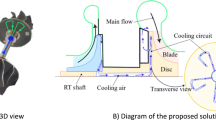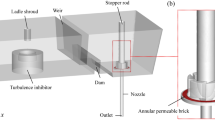Abstract
This paper investigates the regulation of the interior turbulent flow in a wet submersible motor using three-dimensional numerical simulation method based on ANSYS-CFD software. The model of the turbulent flow field between the rotor and the stator in the 850QS-3200 type wet submersible motor as an example was established to study the turbulent flow regulation of the axial-flow cooling water. The numerical investigation was carried out in wet submersible motor with different rotor outer surface roughness, i.e., 0.1, 0.3, 0.5, 0.7 and 0.9, with different rotor rotating speeds, i.e., 600, 1000, 1450, 1800, and 2200 r/min, and different flow rates of axial-flow cooling water, i.e., 0.5, 0.75, 1, 1.25 and 1.5 m/s. The distribution rules of the pressure, the absolute velocity and the velocity pathlines in the turbulent flow field were studied. The results show that these three factors have various different action mechanism and different degree of influence on the pressure distribution, absolute velocity distribution and velocity pathlines, which could provide a theoretical guide for the optimization of the rotor and stator system in wet submersible motor.












Similar content being viewed by others
References
Vardy, A. E., & Brown, J. M. B. (2003). Transient turbulent friction in smooth pipe flows. Journal of Sound and Vibration, 259(5), 1011–1036.
Lu, J., Ding, J., Yang, J., et al. (2014). Steady dynamical behaviors of novel viscous pump with groove under the rotor. International Journal of Heat and Mass Transfer, 73, 170–176.
Wiggert, D. C., & Tijsseling, A. S. (2001). Fluid transients and fluid-structure interaction in flexible liquid-filled piping. Applied Mechanics Reviews, 54(5), 455–481.
Issa, R. I., & Kempf, M. H. W. (2003). Simulation of slug flow in horizontal and nearly horizontal pipes with the two-fluid model. International Journal of Multiphase Flow, 29(1), 69–95.
Adebayo, D. S., & Rona, A. (2017). Numerical investigation of the three-dimensional pressure distribution in Taylor Couette flow. Journal of Fluids Engineering, 139(11), 111201.
Rivero-Rodriguez, J., & Pérez-Saborid, M. (2015). Numerical investigation of the influence of gravity on flutter of cantilevered pipes conveying fluid. Journal of Fluids and Structures, 55, 106–121.
Boye, T. G. E., Nwaoha, T. C., Olusegun, S. D., et al. (2011). A validation method of computational fluid dynamics (CFD) simulation against experimental data of transient flow in pipes system. Nuclear Technology, 176(2), 238–259.
Lee, K., & Yang, K. S. (2017). Large Eddy simulation of turbulent flow past a circular cylinder in the subcritical and critical regimes. Journal of Mechanical Science and Technology, 31(4), 1729–1737.
Sengupta, T. K., & Gullapalli, A. (2016). Enstrophy-based proper orthogonal decomposition of flow past rotating cylinder at super-critical rotating rate. Physics of Fluids, 28(11), 107–114.
Mittal, S., & Kumar, B. (2003). Flow past a rotating cylinder. Journal of Fluid Mechanics, 476, 303–334.
Bourguet, R., & Jacono, D. L. (2014). Flow-induced vibrations of a rotating cylinder. Journal of Fluid Mechanics, 740, 342–380.
Rao, A., Radi, A., Leontini, J. S., et al. (2015). A review of rotating cylinder wake transitions. Journal of Fluids and Structures, 53, 2–14.
Lu, L., Liu, M., Teng, B., et al. (2014). Numerical investigation of fluid flow past circular cylinder with multiple control rods at low Reynolds number. Journal of Fluids and Structures, 48, 235–259.
Cheng, M., & Luo, L. S. (2007). Characteristics of two-dimensional flow around a rotating circular cylinder near a plane wall. Physics of Fluids, 19(6), 063601.
Karabelas, S. J. (2010). Large eddy simulation of high-Reynolds number flow past a rotating cylinder. International Journal of Heat and Fluid Flow, 31(4), 518–527.
Pralits, J. O., Brandt, L., & Giannetti, F. (2010). Instability and sensitivity of the flow around a rotating circular cylinder. Journal of Fluid Mechanics, 650, 513–536.
Kumar, S., Cantu, C., & Gonzalez, B. (2011). Flow past a rotating cylinder at low and high rotation rates. Journal of Fluids Engineering, 133(4), 041201.
Bao, X., Sheng, H., Shan, L., et al. (2013). Analysis of rotor 3D temperature field for high-voltage wet submersible motor. Large Electric Machine and Hydraulic Turbine, 1, 50–54.
Carrión, M., Steijl, R., Woodgate, M., et al. (2015). Computational fluid dynamics analysis of the wake behind the MEXICO rotor in axial flow conditions. Wind Energy, 18(6), 1023–1045.
Selimefendigil, F., & Öztop, H. F. (2014). Effect of a rotating cylinder in forced convection of ferrofluid over a backward facing step. International Journal of Heat and Mass Transfer, 71, 142–148.
Sen, S., De Nayer, G., & Breuer, M. (2016). A fast and robust hybrid method for block-structured mesh deformation with emphasis on FSI-LES applications. International Journal for Numerical Methods in Engineering, 111(3), 273–300.
Ljungskog, E., Sebben, S., Broniewicz, A., et al. (2017). A parametric study on the influence of boundary conditions on the longitudinal pressure gradient in CFD simulations of an automotive wind tunnel. Journal of Mechanical Science and Technology, 31(6), 2821–2827.
Mathur, A., Srivastava, A., Mathur, J., et al. (2015). Transient effect of soil thermal diffusivity on performance of EATHE system. Energy Reports, 1, 17–21.
Bao, X. H., & Sheng, H. J. (2013). Analysis of water friction loss and calculation of rotor 3D temperature field for wet submersible motor. Applied Mechanics and Materials, 325, 437–440.
Ding, H., Visser, F. C., Jiang, Y., et al. (2011). Demonstration and validation of a 3D CFD simulation tool predicting pump performance and cavitation for industrial applications. Journal of Fluids Engineering, 133(1), 011101.
Lei, T., Shu-Liang, C., Yu-Ming, W., et al. (2012). Numerical simulation of cavitation in a centrifugal pump at low flow rate. Chinese Physics Letters, 29(1), 014702.
Acknowledgements
The first author would like to thank the process technology group at the School of Mechanical Electronic and Information Engineering for his help at China University of Mining and Technology. This work was financially supported by the Henan Rescuing Center for Mineral Disaster and Engineering Laboratory for Mine Drainage Technology and Equipment in Zhengzhou.
Author information
Authors and Affiliations
Corresponding author
Rights and permissions
About this article
Cite this article
Zheng, X., Wang, Y., Jiang, M. et al. Numerical Simulation of Interior Turbulent Flow Regulation of Wet Submersible Motor. Wireless Pers Commun 102, 1443–1459 (2018). https://doi.org/10.1007/s11277-017-5204-1
Published:
Issue Date:
DOI: https://doi.org/10.1007/s11277-017-5204-1




